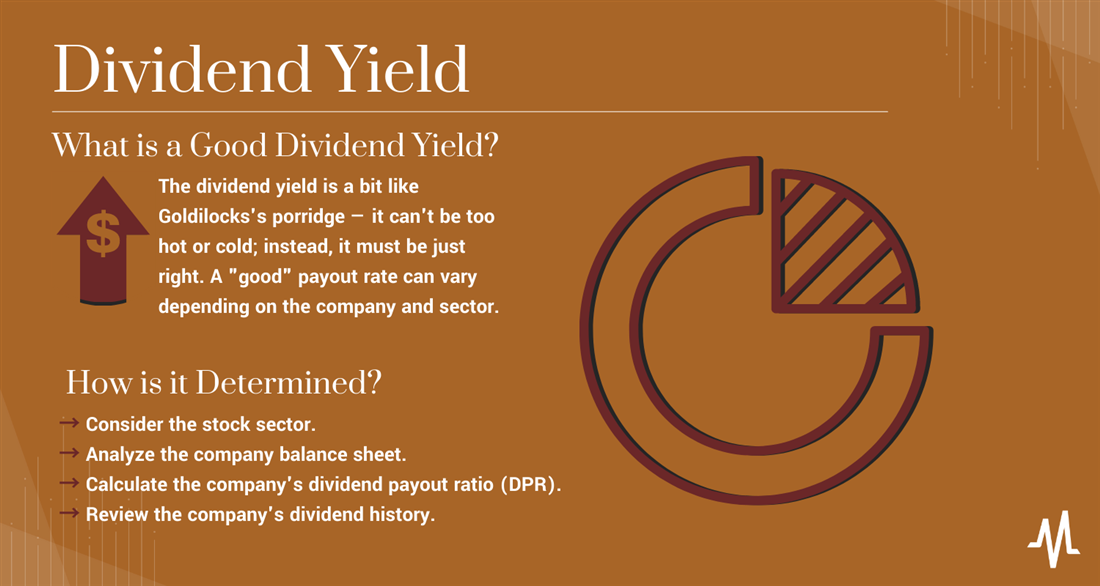What is a good dividend yield, exactly? When evaluating different stocks to invest in, you'll notice some pay high dividends, some pay low dividends, and others pay none.
A dividend is a portion of a company's profits returned to shareholders as income, so naturally, we'd want to search for companies paying the highest dividend yield, right? Well, not exactly. Evaluating dividends is more complex than buying stocks with the highest yield stock dividends. Many factors come into play when considering dividends, not just the highest yield.
You'll need to understand a few different ratios and valuation metrics to determine if a company pays a good dividend yield.
What is Dividend Yield?
Calculating dividend yield is a relatively simple equation to solve. The dividend yield is a percentage (not the total dividend payout a company uses to reward investors). Instead, the yield is a metric used to evaluate cash flow or the rate a company returns profits to its stockholders on a per-share basis. The dividend yield may not tell you much about an individual firm, but it's a helpful measurement for comparing stocks and industries. The calculation for dividend yield looks like this:
Dividend Yield = Annual Dividend Payout Amount per Share / Price per Share
As you can see, the dividend yield fluctuates over time as share prices gyrate, so using dividend yield as your only evaluation metric would be foolhardy. Moreover, the dividend yield isn't a forward-looking metric and tells us little in isolation about a company's prospects. So what is a good average dividend yield? You'll need to consider a few other evaluation formulas to answer that.

What is a Good Dividend Yield?
Determining a good dividend yield requires more than just knowing the number.
Is a 2% yield good? What about a 5% yield? Obviously, a company with a dividend yield of 5% is better for investment than one with a 2% yield, right? You might be surprised, but the answer is a resounding "no." You can't simply look at the yield, select the highest-yielding dividend stocks and expect to outperform the market. The dividend yield is a bit like Goldilocks's porridge — it can't be too hot or cold; instead, it must be just right.
The dividend payout ratio (DPR) is a critical metric for evaluating the sustainability of a company's dividend. Instead of dividing the annual dividend payout by the share price as in dividend yield, the DPR looks at the percentage of a company's profits that goes toward paying dividends. The DPR formula looks like this:
Dividend Payout Rate = Total Dividends / Company Net Income
You can also find the dividend payout rate by taking the dividend payout per share and dividing it by net income per share. The DPR number shows how much (or little) a burden the dividend payout is on the company's balance sheet.
Once again, a "good" payout rate can vary depending on the company and sector, but it's easier to discern a stable dividend from a troubled one using the DPR calculation. For example, a payout rate of 30% is good for a company in a more growth-focused industry like tech, where retaining profits for R&D is crucial. On the other hand, an established company with little need for extensive R/D, like a bank or consumer staples producer, can have a payout rate over 50% and still be considered healthy.
If you see a dividend payout rate above 90%, be cautious. A company that devotes 90% or more of its earnings to a dividend could be in a precarious position should financial difficulties arise. Even the most mature and cost-conscious companies cannot sustain paying a dividend that absorbs too much of their net income. If the company can't sustain its dividend, it'll cut it. Dividend cuts can be brutal since investors lose out on expected income, faith in the company's future could go down and the stock price could fall.
Why Do You Need to Know Dividend Yield?
The dividend yield isn't a ratio you can use alone to evaluate a specific stock, but it's still a useful formula for investors. Comparing a rate to the share price provides more information than a dividend payout. A company with a $200 stock price paying $2 per share annually in dividends isn't rewarding shareholders as well as a company with a $50 stock price that pays $1.75 in annual dividends.
The dividend yield helps compare dividends across different stocks and sectors. For example, using dividend yield is how we know tech companies retain more earnings for growth than consumer staples or utility companies. Comparing the dividend yield of different sectors can be a good risk assessment tool when building a portfolio. Plus, you can compare the dividend yield of similar companies within the same sector to find the ones returning the most capital to shareholders. To find and compare different yields, use MarketBeat's dividend yield calculator.
When is a Dividend Yield Too Low?
A low dividend yield isn't necessarily a cause for concern. For example, Apple Inc. (NASDAQ: AAPL) pays a small yield because it retains most of its earnings for research and development in new projects. Apple's stock performance over time shows that investors are still getting rewarded even in the absence of large dividends.
Instead of simply looking at a company's dividend yield, compare it to other companies in the sector. A consumer staples firm paying a 2% dividend might be a worse investment than a tech firm paying a 1% dividend. Additionally, use the dividend payout ratio to estimate the sustainability of specific dividend yields.
When is a Dividend Yield Too High?
On the other hand, a high dividend yield doesn't necessarily mean the payout is at risk. Companies in certain industries consistently pay high dividends to reward shareholders for taking on unique risks. Cigarette companies like Altria Group Inc. (NYSE: MO) pay extraordinarily high yields since tobacco has many health risks and is heavily regulated and taxed by the government.
Again, a better method for determining whether a yield is too high would be to compare rates amongst rivals in their sector or to use the dividend payout rate to measure sustainability. A high dividend yield could be due to industry-specific reasons, like REITs, sin stocks and heavily regulated industries like utilities.
What Causes a Dividend Yield to Get Too High?
Dividend yields can grow out of control for several different reasons. Remember, a high yield doesn't necessarily mean an at-risk payout, but trouble could be on the horizon when the yield rises sharply or the dividend payout rate gets too burdensome.
A sudden drop in stock price is one of the most common reasons a dividend yield gets too high. Since yield ties to stock price, a sharp decline will send the dividend yield skyrocketing in the reverse direction. Additionally, when a company's stock price is under pressure, management won't want to rattle investors further by cutting the dividend.
One example of unsustainable management of a dividend comes from pipeline company Kinder Morgan Inc. (NYSE: KMI). In 2015, Kinder Morgan's stock suffered a significant downturn and the company had to retain more earnings for capital expenditures. As a result, the dividend hit the chopping block and management decided to reduce the quarterly payout by a whopping 75%.
How to Evaluate Dividend Yield
Dividend yield evaluation requires more than just knowing the number. Use the following steps to evaluate the sustainability of a company's dividend yield.
Step 1: Consider the stock sector.
Different industries tend to have different roadmaps when it comes to utilizing earnings. Growth-obsessed tech firms plow their profits back into the company for new ventures, while utilities and consumer staples firms focus more on returning capital to shareholders. When comparing dividend yields, know the average rate for the stock sector you're investigating. Tools like MarketBeat's dividend screener come in handy here.
Step 2: Analyze the company balance sheet.
Since dividends come from company earnings, the balance sheet will be a useful reference for evaluation. Is the company growing earnings to support the dividend? Will future debt obligations make the dividend difficult to manage in the future? Ensure the company you're researching has a sturdy balance sheet to support its dividend yield.
Step 3: Calculate the company's dividend payout ratio (DPR).
Always remember to consider the dividend payout ratio when studying dividend-paying stocks. The DPR helps measure the sustainability of future payouts by showing investors how much earnings capital a company uses to pay its dividend. A high DPR could be evidence of an unsustainable dividend. Use DPR in conjunction with dividend yield to locate the most promising high-dividend stocks.
Step 4: Review the company's dividend history.
Finally, the dividend payout history can be a valuable tool in evaluating yields. For example, companies that have raised dividend payouts for 25 years or more are known as Dividend Aristocrats. Companies that reach this level of consistency are proud of their capital management and want to continue rewarding shareholders. A company's dividend history might not be a crystal ball into its future, but it's another useful piece of information to evaluate.
Dividend Yield Alone Isn't Enough to Properly Evaluate Dividend Stocks
So, what is a good annual dividend yield? The answer depends on a few different factors. High-yielding dividends aren't always the most sustainable, and low-yielding dividends aren't always a sign of mismanaged capital. To properly evaluate a company's dividend yield, you must compare the number to others in the same industry. Also, consider the company's balance sheet and calculate the dividend payout rate. Dividend yield only provides information about the past, but combining this rate with DPR and some balance sheet analysis can offer a glimpse into the dividend's future.
FAQs
Here are a few commonly asked questions about finding good dividend yields:
What is a good average dividend yield?
A good average dividend yield varies depending on the stock sector, industry and other factors such as dividend payout rate. A good average yield in the tech sector will be much lower than in the banking sector. Always use multiple metrics when evaluating a company's dividend.
When is a dividend yield too high?
Dividend yields get too high when a company suffers a significant stock downturn or begins using too much of its earnings for dividend payouts. A high dividend yield isn't necessarily bad, but consider the payout rate and balance sheet when researching these firms.
When is a dividend yield too low?
Again, a low dividend yield isn't necessarily a sign of trouble. To determine whether a dividend yield is too low, compare the company to its peers in the industry and use the payout rate to measure the percentage of profit returned to shareholders.






